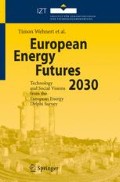Abstract
The main task of this chapter is to deal with and to discuss together the technology push and the social pull aspects of the EurEnDel project. The task has been achieved in two ways, which are pursued simultaneously by exploiting the large and diversified amount of information granted by the replies to the questionnaire.15
All the chapter goes along the already known results of the Delphi, focusing on possible sources of changes with respect to the figures of chapter 4. The methodology is outlined in the notes and Annex D.
Access this chapter
Tax calculation will be finalised at checkout
Purchases are for personal use only
Preview
Unable to display preview. Download preview PDF.
References
The scores of the social impacts of the technology statements are here multiplied for a weight, the value of which depends on the period where the statements in the replies are expected to occur “spontaneously”, i.e. without a policy effort. The weight takes the values 1 if the expected period of occurrence is 2003–2010; 0.8 if it is 2011–2020; 0.6 if 2021–30; 0.4 if it is “after 2030”; 0 if the reply is “Never”. In the report the weight is named “Closeness of occurrence”. It combines features of the “Times of Occurrence” and the “Likelihood of Occurrence” (p. 21). Increasing values signify that the expected time of occurrence is closer to our days. (cf. Annex D — Correspondence Factors)
Rights and permissions
Copyright information
© 2007 Springer-Verlag Berlin Heidelberg
About this chapter
Cite this chapter
(2007). Comparison of Social and Technological Perspectives. In: European Energy Futures 2030. Springer, Berlin, Heidelberg. https://doi.org/10.1007/978-3-540-69165-5_5
Download citation
DOI: https://doi.org/10.1007/978-3-540-69165-5_5
Publisher Name: Springer, Berlin, Heidelberg
Print ISBN: 978-3-540-69164-8
Online ISBN: 978-3-540-69165-5
eBook Packages: EngineeringEngineering (R0)

